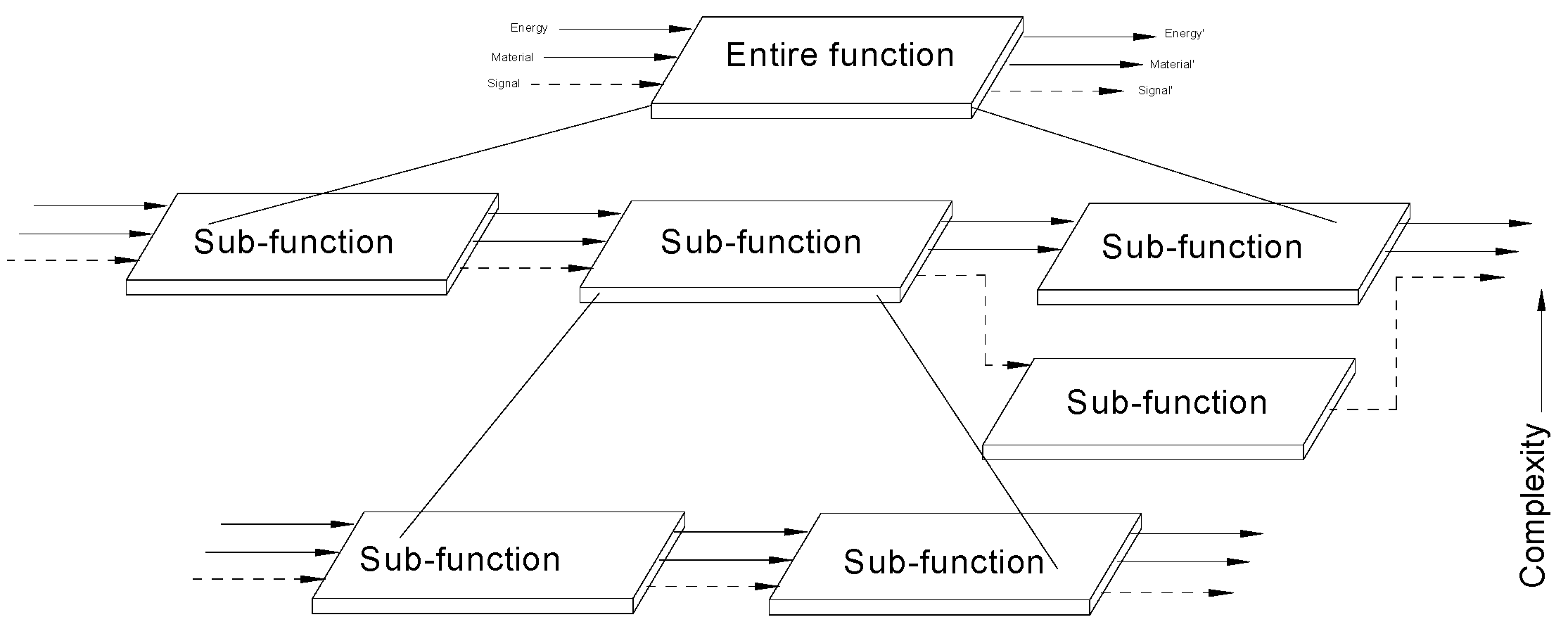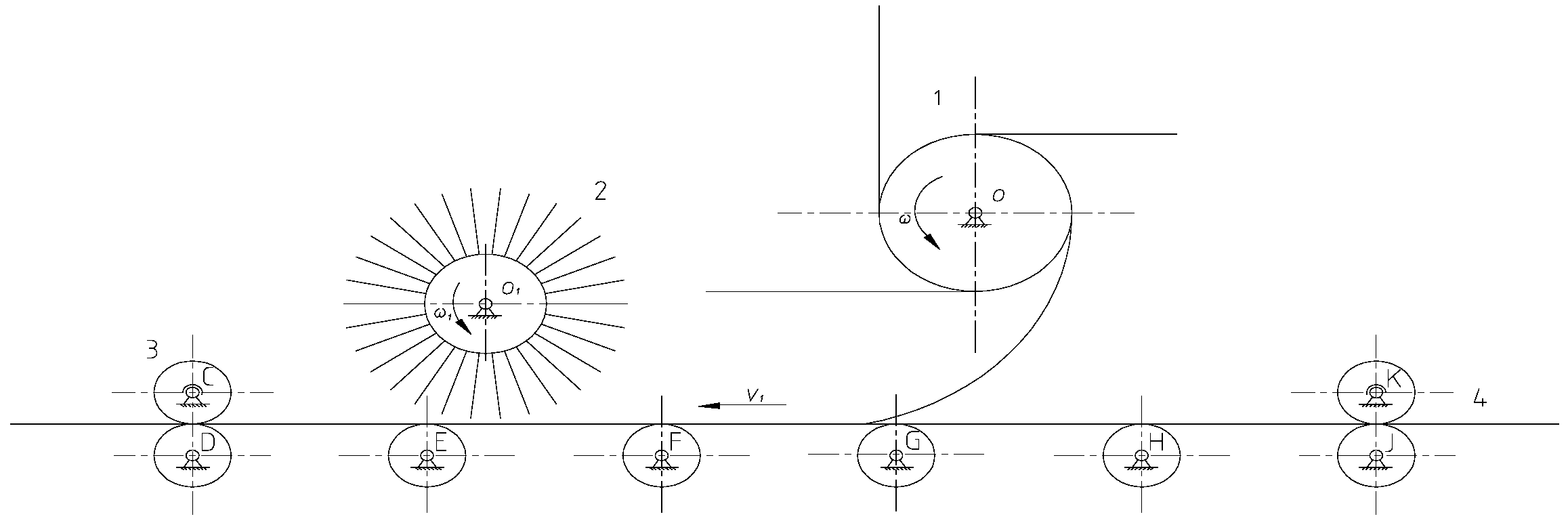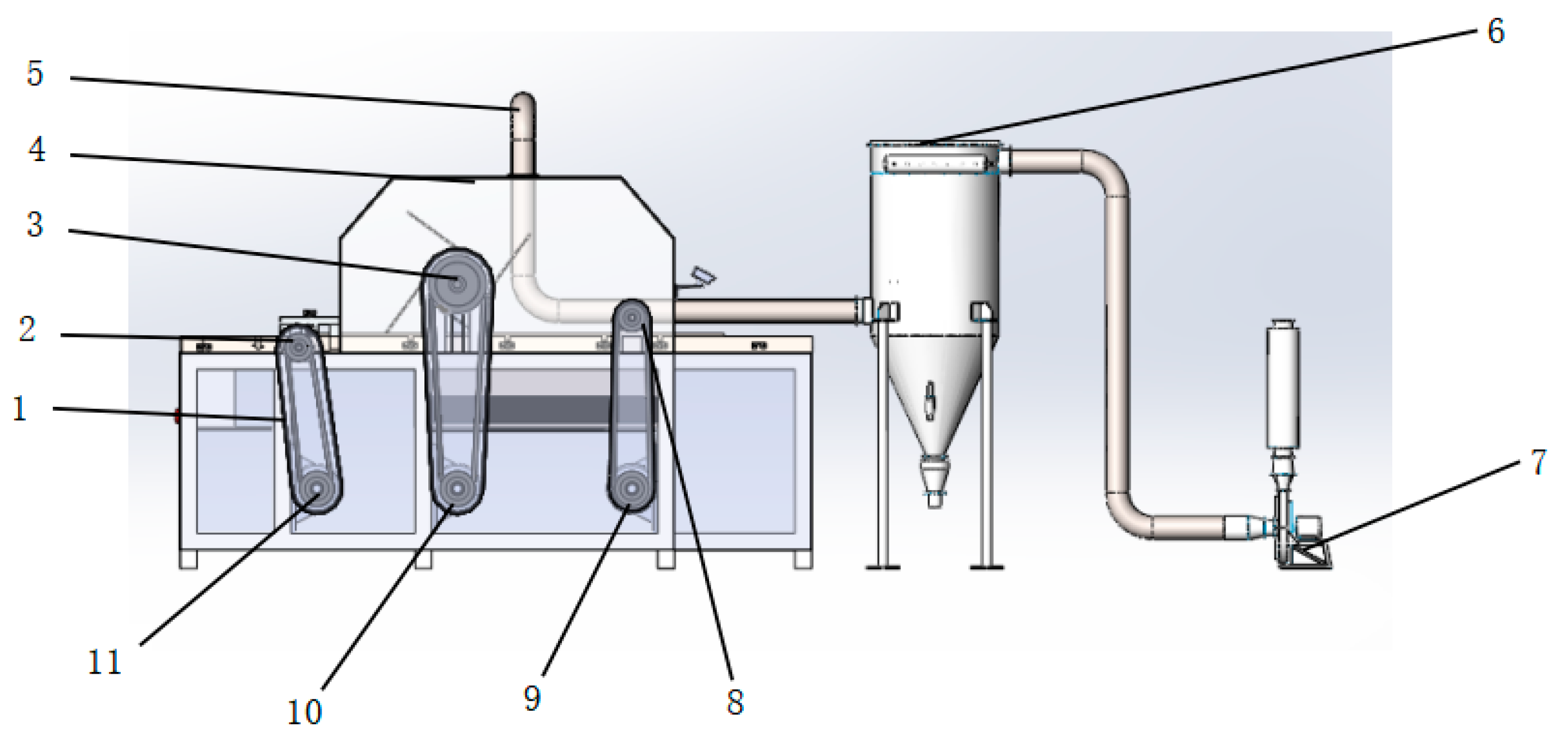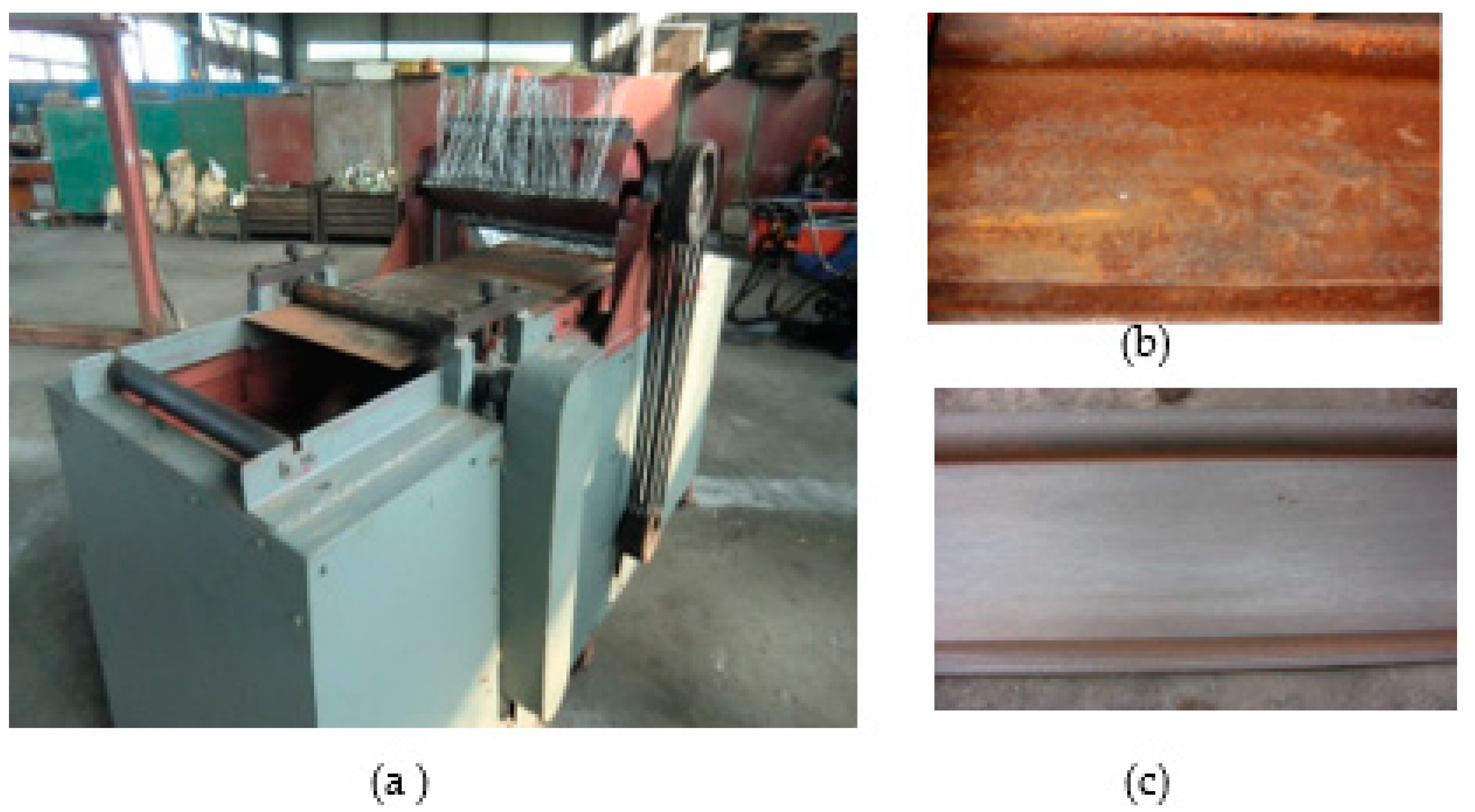A Green Design Method for a Rust-Off Machine Based on QFDE and Function Analysis
Abstract
:1. Introduction
2. Methodology
2.1. Demand Analysis for Rust-Off Machines
2.2. Engineering Parameter Transformation for Rust-Off Machines
- (1)
- Engineering metrics interrelationship matrix, denoted by P; Pj,k represents the correlation coefficient between the jth engineering metric and kth engineering metric, with a smaller coefficient indicating a weaker relationship.
- (2)
- Engineering metrics roll-out table consists mainly of engineering metrics such as wear resistance, ease of reprocessing, and ease of recycling, with ECj denoting the jth engineering metric.
- (3)
- The customer requirements roll-out table, which mainly includes environmental friendliness, ease of use, safe and reliability, etc., is represented by CRi for the ith customer demand. Customer weight was assigned to customer requirements using the Likert scale method.
- (4)
- Correlation matrix between customer requirements and engineering metrics, denoted by A. Ai,j represents the correlation between the ith customer requirement and jth engineering metric. The higher the value, the higher the correlation.
- (5)
- The relative weight of engineering metrics was obtained by multiplying the importance with a matrix of correlations between customer requirements and engineering metrics.
2.3. Function Analysis for Rust-Off Machines
2.4. Structure Scheme for Rust-Off Machines
3. Case Study
3.1. Demand Analysis for the Steel Plate Rust-Off Machine
3.2. Engineering Parameter Transformation for the Steel Plate Rust-Off Machine
3.3. Function Analysis for the Steel Plate Rust-Off Machine
3.4. Structural Scheme for the Steel Plate Rust-Off Machine
4. Results and Discussion
5. Conclusions
Author Contributions
Funding
Institutional Review Board Statement
Informed Consent Statement
Data Availability Statement
Conflicts of Interest
References
- Liu, G.; Liu, Z.; Li, G. Green Design and Green Manufacturing; Press of Machinery Industry: Beijing, China, 2000; pp. 1–9. [Google Scholar]
- Jnr, B.A.; Majid, M.A.; Romli, A. A generic study on Green IT/IS practice development in collaborative enterprise: Insights from a developing country. J. Eng. Technol. Manag. 2020, 55, 101555. [Google Scholar]
- Fu, Z.H.; Peng, Y.C. Green design method of products. Mech. Des. Res. 2000, 10–12+6. [Google Scholar] [CrossRef]
- Jnr, B.A. Examining the role of green IT/IS innovation in collaborative enterprise-implications in an emerging economy. Technol. Soc. 2020, 62, 101301. [Google Scholar]
- Gong, Q.; Xiong, Y.; Jiang, Z.; Yang, J.; Chen, C. Timing Decision for Active Remanufacturing Based on 3E Analysis of Product Life Cycle. Sustainability 2022, 14, 8749. [Google Scholar] [CrossRef]
- Chen, J.; Zhang, S.L.; Li, X.; Chen, K. Research on relative greenness of environmental awareness design scheme based on fuzzy AHP-TOPSIS. Sci. Technol. Rep. 2016, 34, 304–313. [Google Scholar]
- Tao, F.; Bi, L.N.; Zuo, Y.; Nee, A.Y.C. A hybrid group leader algorithm for green material selection with energy consideration in product design. CIRP Ann. Manuf. Technol. 2016, 65, 9–12. [Google Scholar] [CrossRef]
- Zhang, L.; Zheng, C.X.; Zhong, Y.J.; Qin, X. Mechanical product green design knowledge update based on rough set. China Mech. Eng. 2019, 30, 595–602. [Google Scholar]
- Xin, L.L.; Jia, X.J.; Li, F.Y.; Wang, X.W.; Chen, X.X. Green feature modeling for mechanical and electrical product conceptual design. Comput. Integr. Manuf. Syst. 2012, 18, 713–718. [Google Scholar]
- Wang, Z.X.; Zhang, T.Q.; Yu, T.B.; Zhao, J. Assessment and optimization of grinding process on AISI 1045 steel in terms of green manufacturing using orthogonal experimental design and grey relational analysis. J. Clean. Prod. 2020, 253, 119896. [Google Scholar] [CrossRef]
- Tian, G.; Zhang, C.; Fathollahi-Fard, A.M.; Li, Z.; Zhang, C.; Jiang, Z. An Enhanced Social Engineering Optimizer for Solving an Energy-Efficient Disassembly Line Balancing Problem Based on Bucket Brigades and Cloud Theory. IEEE Trans. Ind. Inform. 2022. [Google Scholar] [CrossRef]
- Ajukumar, V.N.; Gandhi, O.P. Evaluation of green maintenance initiatives in design and development of mechanical systems using an integrated approach. J. Clean. Prod. 2013, 51, 34–46. [Google Scholar] [CrossRef]
- Smith, S.; Chen, W. Rule-based recursive selective disassembly sequence planning for green design. J. Adv. Eng. Inf. 2011, 25, 77–87. [Google Scholar] [CrossRef]
- Wang, J.Z.; Zhang, L.Q.; Han, X.M.; Zhu, C.J.; Wang, L.H. Development of green design platform for key components of high-end equipment based on modularization. J. Manuf. Autom. 2021, 43, 114–117. [Google Scholar]
- Agrawal, V.V.; Ülkü, S. The Role of Modular Upgradability as a Green Design Strategy. Manuf. Serv. Oper. Manag. 2013, 15, 523–700. [Google Scholar] [CrossRef]
- Zhang, F.Y.; Zhang, H.C.; Zheng, H.; Zhang, Q.Q. Study on Green Innovative Design Based on Function Analysis. Appl. Mech. Mater. 2010, 44, 44–47. [Google Scholar]
- Younesi, M.; Roghanian, E. A Framework for Sustainable Product Design: A Hybrid Fuzzy approach Based on Quality Function Deployment for Environment. J. Clean. Prod. 2015, 108, 385–394. [Google Scholar] [CrossRef]
- Gong, Q.S.; Zhang, H.; Jiang, Z.G.; Ma, F. Methodology for steel plate remanufacturing cleaning with flexible cable impact contact and friction. Procedia CIRP 2018, 72, 1374–1379. [Google Scholar] [CrossRef]
- Xu, B.S.; Li, E.Z.; Zheng, H.D.; Sang, F.; Shi, P.J. The remanufacturing industry and its development strategy in China. China Eng. Sci. 2017, 19, 61–65. [Google Scholar]
- Tian, G.D.; Yuan, G.; Aleksandrov, A.; Zhang, T.Z.; Li, Z.W.; FathollahiFard, A.M.; Ivanov, M. Recycling of spent lithiumion batteries a comprehensive review for identification of main challenges and future research trends. Sustain. Energy Technol. Assess. 2022, 53, 102447. [Google Scholar]
- Gong, Q.S.; Zhang, H.; Jiang, Z.G.; Wang, H.; Wang, Y.; Hu, X.L. Nonempirical hybrid multi-attribute decision-making method for design for remanufacturing. Adv. Manuf. 2019, 7, 423–437. [Google Scholar] [CrossRef]
- Jiao, X.L.; Hu, Z.G. Study on improvement design decision of sewing product based on house of quality. Manuf. Autom. 2011, 33, 139–142. [Google Scholar]
- Keijiro, M.; Tomohiko, S.K.; Mitsuru, K.; Atsushi, I. Applying Quality Function Deployment to environmentally conscious design. Int. J. Qual. Reliab. Manag. 2003, 20, 90–106. [Google Scholar]
- Edmund, S.M.; Rajesh, A. Gear concept selection procedure using fuzzy QFD, AHP and tacit knowledge. Cogent Eng. 2020, 7, 1802816. [Google Scholar]
- Gong, Q.S. Research on Multi-Objective Optimization Design Method of Mechanical Equipment Design for Remanufacturing; Wuhan University of Science and Technology: Wuhan, China, 2020. [Google Scholar]
- Ma, F.; Zhang, H.; Gong, Q.S.; Hon, K.K.B. A novel energy efficiency grade evaluation approach for machining systems based on inherent energy efficiency. Int. J. Prod. Res. 2020, 59, 6022–6033. [Google Scholar] [CrossRef]
- Ma, F.; Zhang, H.; Gong, Q.S.; Hon, K.K.B. A novel energy evaluation approach of machining processes based on data analysis. Energy Sources Part A Recovery Util. Environ. Eff. 2019, 1–15. [Google Scholar]









| Total Customer Requirements | Customer Requirements |
|---|---|
| Functionality | Specific customer requirements regarding functionality |
| Reliability | Specific customer requirements regarding reliability |
| Economy | Specific customer requirements regarding economy |
| Environmental performance | Specific customer requirements regarding environmental performance |
| Total Customer Requirements | Customer Requirements | Engineering Metrics |
|---|---|---|
| Functionality | Specific customer requirements regarding functionality | Technical features that are closely related to specific customer requirements regarding functionality |
| Reliability | Specific customer requirements regarding reliability | Technical features that are closely related to specific customer requirements regarding reliability |
| Economy | Specific customer requirements regarding economy | Technical features that are closely related to specific customer requirements regarding economy |
| Environmental performance | Specific customer requirements regarding environmental performance | Technical features that are closely related to specific customer requirements regarding environmental performance |
| Total Customer Requirements | Customer Requirements |
|---|---|
| Functionality | Automation () |
| Good descaling performance () | |
| Reliability | High reliability () |
| Long service life () | |
| Low vibration () | |
| High security () | |
| Economy | Moderate price () |
| High efficiency () | |
| Easy to maintain () | |
| Environmental performance | Harmless to environment () |
| Low noise () | |
| Easy to remanufacture () |
| Total Customer Requirements | Customer Requirements | Engineering Metrics |
|---|---|---|
| Functionality | Automation () | Automation level () |
| Good descaling performance () | Abrasion resistance () | |
| Reliability | High reliability () | Reliability () |
| Long service life () | Frictional sub-gap () | |
| Low vibration () | Mechanical vibration () | |
| High security () | Movement coordination () | |
| Economy | Moderate price () | Cost (), Corrosion resistance () |
| High efficiency () | Energy consumption () | |
| Easy to maintain () | After-sales service () | |
| Environmental performance | Harmless to the environment () | Easy to upgrade () |
| Low noise () | Noise () | |
| Easy to remanufacture () | Easy to recycle (), Easy to disassemble (), Easy to clean (), Easy to detect and sort (), Easy to detect and sort (), Easy to reassemble (), Easy to test () |
| Relational Strength between Customer Requirements and Engineering Metrics | Relational Strength between Engineering Metrics | ||||
|---|---|---|---|---|---|
| Relational Strength | Symbol | Numerical Value | Relational Strength | Symbol | Numerical Value |
| Strong | ● | 9 | Strong positive | ● | 9 |
| General | ○ | 3 | Strong | ○ | 3 |
| Weak | △ | 1 | Negative | × | −3 |
| No | Blank | 0 | Strong negative | * | −9 |
| No | Blank | 0 | |||
| Engineering Metrics | Phase I Relative Weights | Flexible Cable | Rolling Brush | Roller | Spindle | Bearing | Duster | Dust Collector | Protective Cover | Reducer |
|---|---|---|---|---|---|---|---|---|---|---|
| 0.105 | 3 | 3 | 3 | 3 | 3 | 3 | 1 | 3 | ||
| 0.076 | 9 | 3 | 9 | 3 | 9 | 3 | 3 | 9 | 3 | |
| 0.076 | 3 | 3 | 9 | 9 | 3 | 3 | 3 | 9 | ||
| 0.020 | 3 | 3 | 3 | 9 | 3 | 3 | 3 | 3 | ||
| 0.039 | 9 | 3 | 9 | 9 | 3 | 1 | 1 | 9 | 3 | |
| 0.037 | ||||||||||
| 0.008 | 9 | 3 | 3 | 3 | 1 | 3 | 3 | 3 | 3 | |
| 0.063 | 9 | 3 | 1 | 3 | 3 | 3 | 3 | 9 | ||
| 0.039 | 3 | 3 | 3 | 3 | 3 | 3 | 3 | 3 | ||
| 0.095 | 9 | 3 | 3 | 3 | 3 | 3 | 3 | 1 | 9 | |
| 0.003 | 3 | 3 | 3 | 3 | 3 | |||||
| 0.076 | 1 | 1 | 1 | 1 | 1 | 3 | 3 | 3 | ||
| 0.071 | 1 | 3 | 3 | 3 | 3 | 3 | 3 | 3 | 3 | |
| 0.047 | 3 | 3 | 9 | 3 | 1 | 3 | 3 | 9 | 3 | |
| 0.047 | 1 | 3 | 9 | 3 | 3 | 3 | 3 | 3 | 9 | |
| 0.044 | 3 | 1 | 1 | 3 | 1 | 1 | 1 | 3 | ||
| 0.039 | 3 | 1 | 3 | 1 | 1 | 3 | 3 | 1 | 3 | |
| 0.068 | 9 | 1 | 3 | 1 | 1 | 1 | 1 | 1 | ||
| 0.047 | 9 | 3 | 3 | 3 | 3 | 3 | 3 | 1 | 3 | |
| Relative weights | 4.877 | 2.435 | 4.656 | 3.333 | 2.64 | 2.578 | 2.353 | 3.286 | 4.43 |
| Parts | Types of Parts | Price | Characteristics |
|---|---|---|---|
| Flexible cable | Steel wire | 12 CNY/kg | Harder than iron wire, better elasticity |
| Wire rope | 21 CNY/kg | Wear resistance, corrosion resistance, not easy to break suddenly, good operation stability, and lightweight | |
| Iron wire | 9 CNY/kg | Softer, better plasticity | |
| Brass wire | 54 CNY/kg | Good flexibility, high cost, high quality | |
| Pencil rod | 11 CNY/m | Extensive tensile strength, good cold bending performance | |
| Roller | Roller conveyor | 55 CNY/m | Simple structure, reliable operation, easy to maintain, change in conveying direction |
| Belt conveyor | 60 CNY/m | Steady transmission, low noise, short life of the belt | |
| Chain delivery | 50 CNY/m | Small force on shaft and bearing, impact, vibration, and noise | |
| Electric drum | 100 CNY/m | Compact structure, low maintenance cost, high reliability, poor soft start performance | |
| Reducer | Planetary gear reducer | 340 CNY/unit | High load, high efficiency, complex installation |
| RV (Rotate Vector) reducer | 200 CNY/unit | High speed, light load | |
| Turbo worm gear reducer | 290 CNY/unit | Large deceleration range, low work efficiency | |
| Cylindrical gear reducer | 159 CNY/unit | Low failure rate, stable operation, high load capacity, easy maintenance, large size |
| Functional Elements | Structure | Expansion Structure |
|---|---|---|
| Fine descaling | Rolling brush | Steel wire brush, Copper wire brush, Winding spring wire brush, Parallel wire brush |
| Main drive | Spindle | 40Cr, 40CrNi, 12CrNi3, 45steel |
| Support spindle | Bearing | Sliding bearing, Rolling bearing, Multi-oil wedge bearing, Gas bearing |
| Dust removal | Duster | Dry mechanical dust collector, Wet dust collector, Granular layer dust collector, Bag filter, Electric dust collector, Pulse dust collector |
| Dust collection | Dust collector | Cyclone separator, Electrostatic precipitator |
| Protection | Protective shield | Steel plate shield, Glass shield |
| Engineering Metrics | Flexible Cable | Rolling Brush | Roller | Spindle | Bearing | Duster | Dust Collector | Protective Cover | Reducer | Score | ecj |
|---|---|---|---|---|---|---|---|---|---|---|---|
| 3 | 3 | 3 | 9 | 0.41 | |||||||
| 9 | 9 | 3 | 21 | 0.45 | |||||||
| 9 | 3 | 3 | 15 | 0.41 | |||||||
| Engineering Metrics | Customer Weights | … | |||||||||||||
|---|---|---|---|---|---|---|---|---|---|---|---|---|---|---|---|
| 5 | 9 | 9 | 9 | 0.27 | 1.37 | ||||||||||
| 5 | 9 | 9 | 0.41 | 2.05 | |||||||||||
| 2 | 3 | 3 | 1 | 0.03 | 0.06 | ||||||||||
| 5 | 3 | 9 | 0.29 | 1.45 | |||||||||||
| 5 | 9 | 3 | 3 | 9 | 3 | 0.15 | 0.72 | ||||||||
| 3 | 9 | 0.00 | 0.00 | ||||||||||||
| 3 | 3 | 9 | 3 | 3 | 0.04 | 0.12 | |||||||||
| 3 | 9 | 1 | 9 | 0.00 | 0.00 | ||||||||||
| 3 | 3 | 3 | 0.21 | 0.62 | |||||||||||
| 5 | 3 | 3 | 3 | 9 | 0.02 | 0.08 | |||||||||
| 5 | 3 | 9 | 1 | 0.09 | 0.47 | ||||||||||
| 3 | 9 | 0.00 | 0.00 | ||||||||||||
| 0.41 | 0.00 | 0.00 | 0.00 | 0.45 | 0.00 | 0.00 | 0.00 | 0.00 | 0.41 | ||||||
| Amount | 1.51 | 6.88 |
Publisher’s Note: MDPI stays neutral with regard to jurisdictional claims in published maps and institutional affiliations. |
© 2022 by the authors. Licensee MDPI, Basel, Switzerland. This article is an open access article distributed under the terms and conditions of the Creative Commons Attribution (CC BY) license (https://creativecommons.org/licenses/by/4.0/).
Share and Cite
Gong, Q.; Chen, C.; Jiang, Z.; Xiong, Y.; Hu, M.; Yang, J. A Green Design Method for a Rust-Off Machine Based on QFDE and Function Analysis. Sustainability 2022, 14, 9979. https://doi.org/10.3390/su14169979
Gong Q, Chen C, Jiang Z, Xiong Y, Hu M, Yang J. A Green Design Method for a Rust-Off Machine Based on QFDE and Function Analysis. Sustainability. 2022; 14(16):9979. https://doi.org/10.3390/su14169979
Chicago/Turabian StyleGong, Qingshan, Chen Chen, Zhigang Jiang, Yurong Xiong, Mingmao Hu, and Jinghong Yang. 2022. "A Green Design Method for a Rust-Off Machine Based on QFDE and Function Analysis" Sustainability 14, no. 16: 9979. https://doi.org/10.3390/su14169979
APA StyleGong, Q., Chen, C., Jiang, Z., Xiong, Y., Hu, M., & Yang, J. (2022). A Green Design Method for a Rust-Off Machine Based on QFDE and Function Analysis. Sustainability, 14(16), 9979. https://doi.org/10.3390/su14169979







